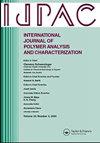用天然催化剂聚合甲基丙烯酸甲酯(MMA)和新型环氧丙烷(PO)共聚物的绿色化学
IF 1.6
4区 工程技术
Q4 POLYMER SCIENCE
International Journal of Polymer Analysis and Characterization
Pub Date : 2025-03-11
DOI:10.1080/1023666X.2025.2474015
引用次数: 0
摘要
发展可持续的聚合方法对于促进绿色化学和减少对环境的影响至关重要。本文讨论了在天然阴离子催化剂下,甲基丙烯酸甲酯(MMA)的数平均分子量为Mn¯=52400g/mol,多分散性为Ip=1.4。聚合反应的产率受镁铁钠离子与单体质量的比例和反应时间的影响。甲基丙烯酸甲酯emma聚合8 h后,马镁石- na +/单体质量比为10%,收率为65%。此外,还通过阳离子聚合合成了环氧丙烷(PO)与甲基丙烯酸甲酯(MMA)的共聚物。该共聚反应在20℃的温度下进行。共聚收率取决于镁铁氢离子的用量和反应时间的长短。这种改性为各种乙烯基和杂环单体的阳离子聚合提供了无毒有效的质子源。用0.25 M H2SO4改性阿尔及利亚蒙脱土,共聚物收率最高。通过1H-NMR、13C-NMR、傅里叶变换红外光谱(FT-IR)、凝胶渗透色谱(GPC)和差示扫描量热(DSC)分析对合成产物的结构进行了确证。本文章由计算机程序翻译,如有差异,请以英文原文为准。
A green chemistry of the polymerization of methyl methacrylate (MMA) and a new copolymer of propylene oxide (PO) using natural catalysts
The development of sustainable polymerization methods is essential for promoting green chemistry and minimizing environmental impact. This manuscript discusses the polymerization of methyl methacrylate (MMA), which resulted in a number-average molecular weight of and polydispersity of , using a natural anionic catalyst. The yield of the polymerization is influenced by the ratio of Maghnite-Na + to monomer weight and the duration of the reaction. A yield of 65% was achieved with a maghnite-Na+/monomer weight ratio of 10% after 8 h of polymerizing methyl methacrylateMMA. Additionally, a new copolymer of propylene oxide (PO) and methyl methacrylate (MMA) was synthesized through cationic polymerization. This copolymerization was conducted in bulk at a temperature of 20 °C. The yield of the copolymerization depends on the amount of maghnite-H+ used and the length of the reaction time. This modification provides a nontoxic and effective proton source for the cationic polymerization of various vinylic and heterocyclic monomers. The highest yield of the copolymer was obtained using Algerian montmorillonite modified with 0.25 M H2SO4. The structures of the synthesized products were confirmed through 1H-NMR, 13C-NMR, Fourier transform infrared spectroscopy (FT-IR), gel permeation chromatography (GPC), and differential scanning calorimetry (DSC) analysis.
求助全文
通过发布文献求助,成功后即可免费获取论文全文。
去求助
来源期刊
CiteScore
3.50
自引率
5.30%
发文量
37
审稿时长
1.6 months
期刊介绍:
The scope of the journal is to publish original contributions and reviews on studies, methodologies, instrumentation, and applications involving the analysis and characterization of polymers and polymeric-based materials, including synthetic polymers, blends, composites, fibers, coatings, supramolecular structures, polysaccharides, and biopolymers. The Journal will accept papers and review articles on the following topics and research areas involving fundamental and applied studies of polymer analysis and characterization:
Characterization and analysis of new and existing polymers and polymeric-based materials.
Design and evaluation of analytical instrumentation and physical testing equipment.
Determination of molecular weight, size, conformation, branching, cross-linking, chemical structure, and sequence distribution.
Using separation, spectroscopic, and scattering techniques.
Surface characterization of polymeric materials.
Measurement of solution and bulk properties and behavior of polymers.
Studies involving structure-property-processing relationships, and polymer aging.
Analysis of oligomeric materials.
Analysis of polymer additives and decomposition products.

 求助内容:
求助内容: 应助结果提醒方式:
应助结果提醒方式:


